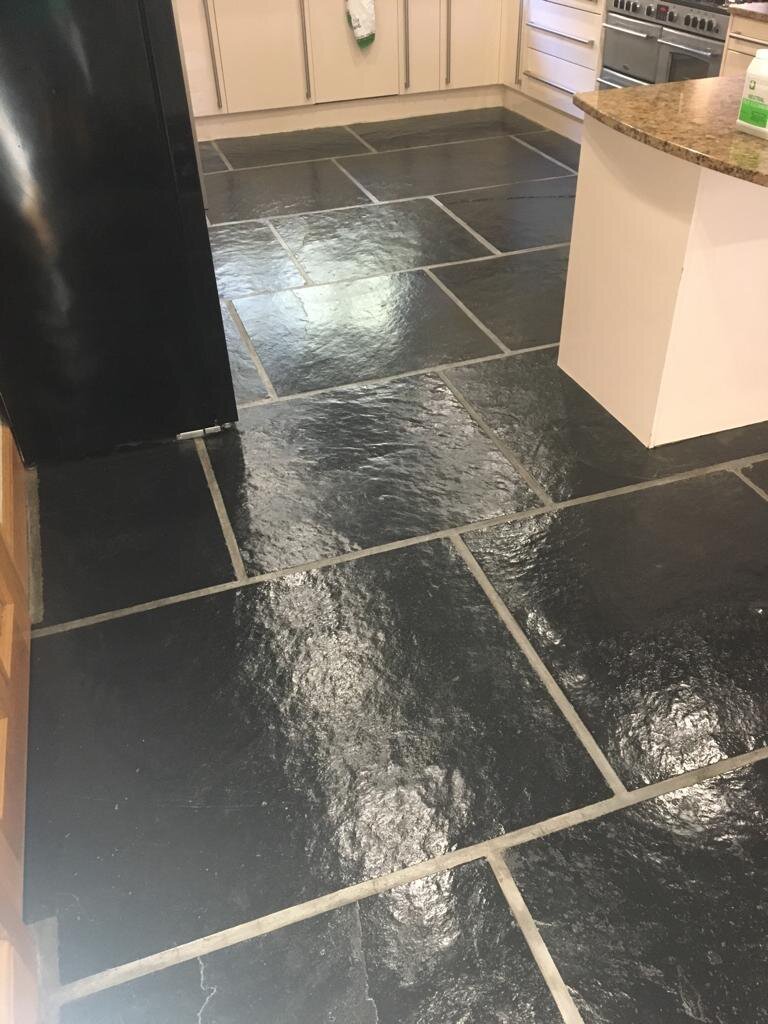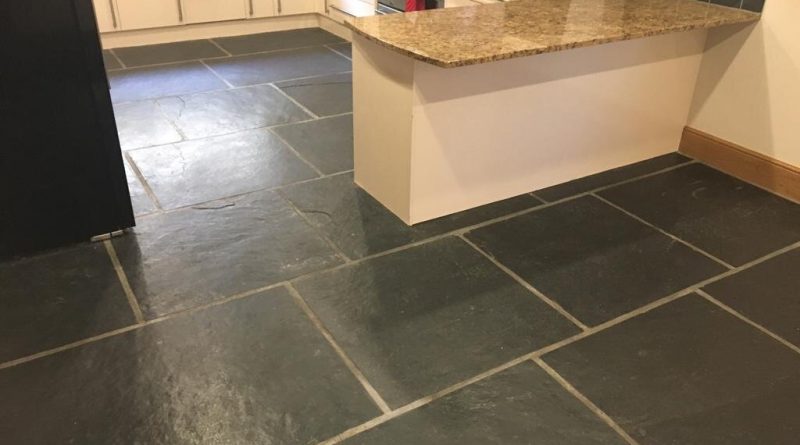Putting new life into large format Slate tiles in Blackwood, Caerphilly
A client of ours recently moved into a relatively new property in the town of Blackwood where the black slate floor looked dull and the grout was stained. Large format slate tiles were installed though the kitchen and adjacent dining and utility room and they were keen to see if the floor could be brought back to life.

I went over to survey the floor and could see that the old sealer was failing and letting dirt into the pores of the stone which was especially notable in the busier parts of the floor which had seen the most foot traffic. The solution would be to strip the floor of the old sealer, clean up the grout and reseal. I conducted a number of test cleans to work out the best way to how best to strip off the old seal and get back down to the natural stone. However, as it turns out removing the old sealer was proving to be quite a job and I was concerned that this task alone could potentially take days.
Unhappy with the way things were going I consulted the Tile Doctor help line and we deduced that the sealer applied previously was most likely a heavy duty/industrial product. My client had only just moved into the property and didn’t know the history of the floor so couldn’t help pin point what was used before. The way forward was to strip the old sealer off the floor using abrasive pads.
Now I had an efficient strategy for renovating the floor I was able to provide the customer with an accurate quote which was accepted, and we agreed a date to return and complete the floor.
Cleaning a Dull Slate Tiled Floor
To begin the restoration, I pre-wet the floor with water and using a weighted floor buffer ran a coarse 100-grit milling pad several times across each tile. This process strips the dirt and sealer off the stone slowly turning the water into a grey slurry. Once the whole floor had been treated in this way, I rinsed the slurry off the floor and extracted it using a wet vacuum. The next step was to repeat the process using a 200-grit burnishing pad which being finer closes the pores in the stone and refines the surface further.
The next step was to clean up the grout using Tile Doctor Pro-Clean which is a strong alkaline cleaner. You apply a strong dilution to the grout lines and then scrub it in with a stiff brush. Fortunately, the slate tiles were large format size so there was less grout to deal with than usual. Once that was done the tile and of course grout was rinsed again with more water and then dried again using the wet vacuum.

I have to admit the stripped slate looked pretty awful at this stage in the restoration, but we were now back to the natural stone which was clean and free of all sealers. I left the floor to dry off fully overnight confident in the knowledge that with the application of a fresh sealer it would look a lot different.
Sealing a Slate Tiled Floor
The next day I returned to the property to seal the floor. Before doing so, however, I needed to test the Slate for moisture as you shouldn’t apply a sealer to a damp floor. The results were fine, so I proceeded to apply the sealer which for this installation I used several coats of Tile Doctor Seal and Go.
I chose Seal and Go for this floor as it works well on Slate resulting in a deep durable satin finish that the customer wanted. Additionally, being a water-based product, it doesn’t leave a smell as it dries.

Within two days the floor was transformed, the grout looked much cleaner and the stone looked new. My client was very happy with the work and left the following message on the Tile Doctor feedback system.
Professional, polite and courteous. Paul went beyond the call of duty to help rejuvenate our slate tiled kitchen and utility room floor. He explained each step of the job and provided advice on aftercare and future maintenance. The results are great and I would gladly recommend the services available.
Andy E, Blackwood
Source: Slate Tile Cleaning and Sealing Service in Blackwood, Caerphilly
